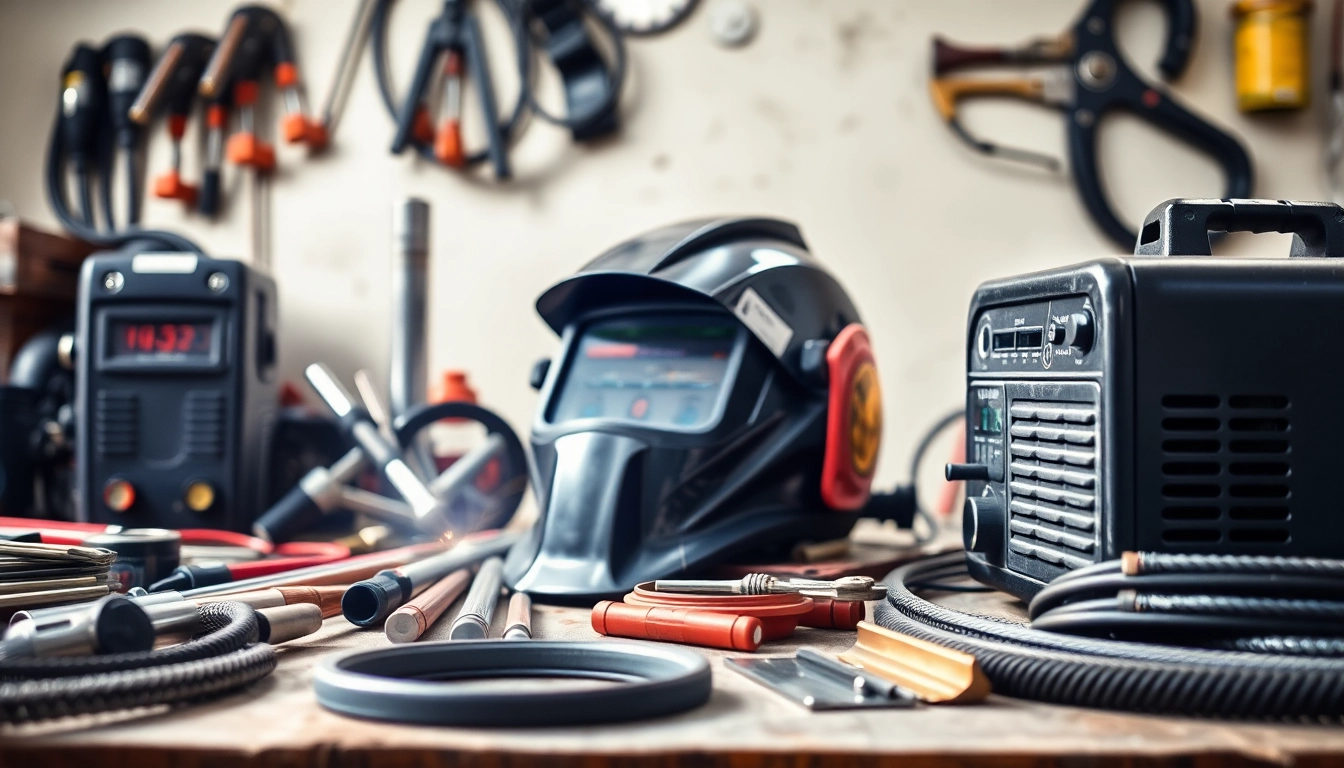Understanding Welding Supplies
When it comes to welding, having the right supplies is critical to the success and safety of any project. The type of welding performed and the materials being used can significantly influence the required equipment and tools. Welding supplies range from machines and electrodes to safety gear and accessories, all of which contribute to both the quality of the weld and the safety of the worker.
Types of Welding Supplies
Welding supplies can be categorized into several essential types that are used depending on the welding process:
- Welding Machines: These include MIG, TIG, and stick welders, each suited to different types of tasks. MIG welders are popular for their ease of use, while TIG welders are preferred for precision work.
- Welding Electrodes: Electrodes come in various classifications and are crucial for creating the arc needed for welds. Common options include solid, flux-cored, and coated stick electrodes.
- Welding Wire: Different welding techniques require specific types of wire, such as ER70S-6 for MIG welding or ER308L for TIG welding.
- Protective Gear: Safety is paramount in welding. Essential protective equipment includes helmets, gloves, jackets, and appropriate footwear.
- Accessories: This encompass items like clamps, magnets, and welding carts, which enhance the welding process.
Why Quality Matters
When investing in welding supplies, it’s imperative to consider the quality of each component. High-quality materials tend to offer better performance, longevity, and safety. Inadequate supplies can lead to poor welds, increased risk of workplace accidents, and unnecessary expenses due to reworks. Purchasing from reputable brands often ensures compliance with industry standards and provides peace of mind regarding durability and efficiency.
Safety Gear Essentials
The importance of safety gear cannot be overstated in the welding profession. Essential safety gear includes:
- Welding Helmets: Protect the welder’s eyes and face from high-intensity light and flying sparks.
- Welding Gloves: Designed to protect hands from heat and sparks while allowing dexterity.
- Welding Jackets: Made from flame-resistant materials, they protect the body from heat and spatter.
- Eye Protection: Safety glasses or goggles are necessary to protect against UV radiation and flying debris.
- Respirators: Protect against harmful vapors, fumes, and dust present in the welding environment.
Choosing the Right Welding Equipment
Selecting the right equipment is essential to ensure weld quality and worker safety. With many options on the market, making an informed choice is vital.
Factors to Consider
When choosing welding equipment, consider the following factors:
- Type of Welding: Different processes such as MIG, TIG, and stick welding have specific equipment needs.
- Material Thickness: The thickness of materials being welded dictates the type of machine and settings needed.
- Skill Level: Beginners might prefer user-friendly machines, while experienced welders may look for advanced features.
- Budget: Quality welding equipment can vary widely in cost. It’s important to balance quality with affordability.
- Brand Reputation: Well-known brands often provide better support, warranty, and reliability.
Popular Brands of Welding Supplies
The market has several reputable brands known for their welding supplies:
- Miller Electric: Renowned for a wide range of welding equipment, including MIG and TIG welders.
- Lincoln Electric: Offers various welding machines, consumables, and accessories with a focus on innovation.
- ESAB: Supplies a diverse selection of welding and cutting equipment.
- Hypertherm: Known primarily for plasma cutting systems, their products are also highly regarded in the welding community.
Comparison of Welding Machines
Choosing the right welding machine often requires comparison between different technologies:
| Type | Advantages | Disadvantages |
|---|---|---|
| MIG Welding | Fast and easy to learn; versatile for various metals. | Not ideal for thick materials; requires shielding gas. |
| TIG Welding | Produces high-quality welds; works well with thin materials. | Slower process; requires more skill and attention. |
| Stick Welding | Portable; works well outdoors and on rusty surfaces. | Can leave slag, requiring additional cleanup. |
Common Welding Techniques and Their Supplies
Various welding techniques require different supplies and equipment tailored to the specific process. Understanding these techniques and their specific supplies can help ensure high-quality work.
MIG Welding Supplies
MIG (Metal Inert Gas) welding is one of the most popular techniques due to its ease of use. Essential supplies include:
- MIG Welding Machine: Capable of handling a range of materials and thicknesses.
- Welding Wire: Usually solid or flux-cored wire, e.g., ER70S-6 for carbon steel welding.
- Gas Supply: Typically argon or a mixture of argon and CO2 for shielding.
- Contact Tips: These conduct electricity from the welding machine to the wire.
TIG Welding Supplies
TIG (Tungsten Inert Gas) welding is known for its precision. Supplies needed for this type of welding include:
- TIG Welding Machine: Provides the necessary amperage and has a non-consumable tungsten electrode.
- Tungsten Electrodes: Available in different sizes and types for specific applications (e.g., pure tungsten, thoriated).
- Filler Rods: Often ER308L for stainless steel and available in various compositions.
- Shielding Gas: Purified argon is commonly used to protect the weld pool.
Stick Welding Supplies
Stick welding (SMAW) is another common method that is valued for its versatility. Key supplies include:
- Stick Welder: A versatile machine suitable for various metals.
- Electrodes: Available in many styles, such as E6013 for general purposes and E7018 for low hydrogen applications.
- Chipping Hammer: Used to remove slag after welding.
- Wire Brush: Essential for cleaning welded joints.
Maintaining Your Welding Supplies
Regular maintenance of welding supplies not only extends their life but also enhances performance and safety. Properly maintained equipment reduces the chances of accidents and improves operational efficiency.
Proper Cleaning Techniques
Cleaning welding supplies is an essential aspect of maintenance. Here are some best practices:
- Welding Machines: Ensure machines are free from dust and debris. Use a soft brush or compressed air to clean surfaces.
- Tig Rods and Electrodes: Store them in dry, dust-free environments. Clean them with a rag to remove any surface contaminants before use.
- Protective Gear: Regularly wash or clean safety equipment per manufacturers’ instructions to ensure its effectiveness.
Storage Tips for Longevity
Proper storage of welding supplies significantly affects their longevity:
- Electrodes: Store in a dry place to prevent corrosion.
- Welding Machines: Keep in a clean, dry environment to avoid rust and debris accumulation.
- Protective Gear: Store helmets and gloves in breathable bags to avoid mold and mildew.
Identifying Wear and Tear
Recognizing signs of wear and tear early can prevent accidents and expensive repairs:
- Inspect Cables: Regularly check for frays and exposed wires.
- Examine Electrodes: Ensure they maintain their shape and function properly. Replace as needed.
- Check Flame and Spark Guards: Regularly inspect protective equipment for any damage.
Where to Buy Quality Welding Supplies
Finding the right place to purchase welding supplies is crucial for obtaining quality equipment and tools at competitive prices. Here’s how to navigate purchasing options effectively.
Online vs. Local Suppliers
Both online and local suppliers have their advantages:
- Online Suppliers: They often provide broader selections and competitive pricing. Also, reviews and ratings can be checked.
- Local Suppliers: Offer personalized service and the ability to physically inspect products before buying. Additionally, local support can be beneficial in emergencies.
Finding Discounts and Deals
To get the most out of your budget when purchasing welding supplies, consider the following strategies:
- Newsletter Sign-ups: Many suppliers offer exclusive discounts for new subscribers.
- Seasonal Sales: Take advantage of seasonal promotions and holidays that often include sales on welding supplies.
- Bulk Buying: Purchasing in bulk can lead to significant savings, especially for consumables like tips and electrodes.
Avoiding Common Purchasing Pitfalls
When purchasing welding supplies, keep these common pitfalls in mind to avoid making costly mistakes:
- Researching Quality: Ensure that you research the brand reputation and customer reviews to avoid poor-quality purchases.
- Assuming Similar Products are Equal: Not all welding supplies are created equal; variations can significantly affect performance.
- Neglecting Total Costs: Consider shipping fees when purchasing online, as they can add to the total cost of supplies.



